Regional Temperature Response in Central Asia to National Committed Emission Reductions
Abstract
1. Introduction
2. Data and Method
2.1. Scenarios
2.2. Simulation of the Climate Models
2.3. Probability Ratio
2.4. Extreme High-Temperature Indices
2.5. Avoided Impacts
3. Results
3.1. Changes in the Surface Air Temperature
3.2. Changes in Extreme High-Temperature Events
3.3. Impacts Avoided Based on Low Warming Scenarios
4. Discussion
5. Conclusions
- (1)
- The SAT in CA will increase by approximately 2.3 °C, 3.0 °C, and 4.8 °C above the preindustrial level under the 1.5 °C, 2.0 °C, and INDC scenarios, with a higher warming rate than the global mean. Larger warming magnitudes will occur in high-latitude areas and the Pamir Mountains. The amplitudes of the PRs of extreme high temperatures will increase much more than those of the mild high temperatures.
- (2)
- Extreme high-temperature events will become more intense, more frequent, and longer-lasting with the enhancement of global warming. The increasing amplitude of the intensity is relatively uniform among CA, while the duration of HWs will increase more in low-altitude areas. The nighttime heat extremes will increase more than the daytime hot extremes (with respect to the frequency index and PR). Record-breaking high-temperature events will be more frequent, and the population/area fraction will linearly increase with the global mean warming.
- (3)
- Compared with the INDC scenario, the lower warming of the 2.0 °C/1.5 °C target scenarios will help to avoid approximately 44–61%/65–80% of the increase in extreme temperature events in terms of the intensity, frequency, and duration in CA. All the subregions would experience such a remarkable impact reduction, although the magnitudes would slightly differ.
Supplementary Materials
Author Contributions
Funding
Acknowledgments
Conflicts of Interest
References
- Alexander, L.V.; Zhang, X.; Peterson, T.C.; Caesar, J.; Gleason, B.; Klein Tank, A.M.G.; Haylock, M.; Collins, D.; Trewin, B.; Rahimzadeh, F.; et al. Global observed changes in daily climate extremes of temperature and precipitation. J. Geophys. Res. Atmos. 2006, 111. [Google Scholar] [CrossRef]
- IPCC. Climate Change 2014: Synthesis Report. Contribution of Working Groups I, II and III to the Fifth Assessment Report of the Intergovernmental Panel on Climate Change; Cambridge University Press: Cambridge, UK; New York, NY, USA, 2014. [Google Scholar]
- Robine, J.M.; Cheung, S.L.K.; Le Roy, S.; Van Oyen, H.; Griffiths, C.; Michel, J.P.; Herrmann, F.R. Death toll exceeded 70,000 in Europe during the summer of 2003. Comptes Rendus Biol. 2008, 331, 171–178. [Google Scholar] [CrossRef]
- Valor, E.; Meneu, V.; Caselles, V. Daily Air Temperature and Electricity Load in Spain. J. Appl. Meteorol. 2001, 40, 1413–1421. [Google Scholar] [CrossRef]
- Lioubimtseva, E.; Cole, R.; Adams, J.M.; Kapustin, G. Impacts of climate and land-cover changes in arid lands of Central Asia. J. Arid Environ. 2005, 62, 285–308. [Google Scholar] [CrossRef]
- Chen, F.; Wang, J.; Jin, L.; Zhang, Q.; Li, J.; Chen, J. Rapid warming in mid-latitude central Asia for the past 100 years. Front. Earth Sci. China. 2009, 3, 42. [Google Scholar] [CrossRef]
- Zhang, M.; Chen, Y.; Shen, Y.; Li, B. Tracking climate change in Central Asia through temperature and precipitation extremes. J. Geogr. Sci. 2019, 29, 3–28. [Google Scholar] [CrossRef]
- Li, P.; Qian, H.; Howard, K.W.F.; Wu, J. Building a new and sustainable Silk Road economic belt. Environ. Earth Sci. 2015, 74, 7267–7270. [Google Scholar] [CrossRef]
- Li, P.; Qian, H.; Zhou, W. Finding harmony between the environment and humanity: an introduction to the thematic issue of the Silk Road. Environ. Earth Sci. 2017, 76, 105. [Google Scholar] [CrossRef]
- Howard, K.W.F.; Howard, K.K. The new Silk Road Economic Belt as a threat to the sustainable management of Central Asia’s transboundary water resources. Environ. Earth Sci. 2016, 75, 976. [Google Scholar] [CrossRef]
- Frachetti, M.D.; Smith, C.E.; Traub, C.M.; Williams, T. Nomadic ecology shaped the highland geography of Asia’s Silk Roads. Nature 2017, 543, 193. [Google Scholar] [CrossRef]
- Adoption of the Paris Agreement: Proposal by the President, FCCC/CP/2015/L.9/Rev.1 ed.; UNFCCC: Geneva, Switzerland, 2015.
- Synthesis Report on the Aggregate Effect of the Intended Nationally Determined Contributions, FCCC/CP/2015/7 ed.; UNFCCC: Paris, France, 2015.
- National Inventory Submissions; UNFCCC: Geneva, Switzerland, 2019.
- Gupta, S.; Tirpak, D.; Burger, N.; Gupta, J.; Höhne, N.; Boncheva, A.; Kanoan, G.; Kolstad, C.; Kruger, J.; Michaelowa, A. Policies, instruments, and co-operative arrangements. In Climate Change 2007: Mitigation. Contribution of Working Group III to the Fourth Assessment Report of the Intergovernmental Panel on Climate Change; Metz, O.B., Bosch, P., Dave, R., Meyer, L., Eds.; Cambridge University Press: Cambridge, UK; New York, NY, USA, 2007; pp. 745–807. [Google Scholar]
- Fawcett, A.A.; Iyer, G.C.; Clarke, L.E.; Edmonds, J.A.; Hultman, N.E.; McJeon, H.C.; Rogelj, J.; Schuler, R.; Alsalam, J.; Asrar, G.R.; et al. CLIMATE POLICY. Can Paris pledges avert severe climate change? Science 2015, 350, 1168–1169. [Google Scholar] [CrossRef] [PubMed]
- Rogelj, J.; den Elzen, M.; Höhne, N.; Fransen, T.; Fekete, H.; Winkler, H.; Schaeffer, R.; Sha, F.; Riahi, K.; Meinshausen, M. Paris Agreement climate proposals need a boost to keep warming well below 2 °C. Nature 2016, 534, 631. [Google Scholar] [CrossRef] [PubMed]
- Sanderson, B.M.; O’Neill, B.C.; Tebaldi, C. What would it take to achieve the Paris temperature targets? Geophys. Res. Lett. 2016, 43, 7133–7142. [Google Scholar] [CrossRef]
- The Emissions Gap Report; UNEP: Nairobi, Kenya, 2017.
- Wang, F.; Tokarska, K.B.; Zhang, J.; Ge, Q.; Hao, Z.; Zhang, X.; Wu, M. Climate Warming in Response to Emission Reductions Consistent with the Paris Agreement. Adv. Meteor. 2018, 2018, 1–9. [Google Scholar] [CrossRef]
- CAT. Addressing global warming. Available online: https://climateactiontracker.org/global/temperatures/ (accessed on 24 July 2019).
- IPCC. Global Warming of 1.5 ºC; Cambridge University Press: Cambridge, UK; New York, NY, USA, 2018. [Google Scholar]
- CI. Climate Scoreboard. Available online: https://www.climateinteractive.org/programs/scoreboard/ (accessed on 25 July 2019).
- Wang, F.; Ge, Q.; Chen, D.; Luterbacher, J.; Tokarska, K.B.; Hao, Z. Global and regional climate responses to national-committed emission reductions under the Paris agreement. Geogr. Ann. Ser. A Phys. Geogr. 2018, 100, 240–253. [Google Scholar] [CrossRef]
- Taylor, K.E.; Stouffer, R.J.; Meehl, G.A. An Overview of CMIP5 and the Experiment Design. Bull. Am. Meteorol. Soc. 2011, 93, 485–498. [Google Scholar] [CrossRef]
- Reichler, T.; Kim, J. How Well Do Coupled Models Simulate Today’s Climate? Bull. Am. Meteorol. Soc. 2008, 89, 303–312. [Google Scholar] [CrossRef]
- Pierce, D.W.; Barnett, T.P.; Santer, B.D.; Gleckler, P.J. Selecting global climate models for regional climate change studies. Proc. Natl. Acad. Sci. USA 2009, 106, 8441. [Google Scholar] [CrossRef]
- Robert, V.; Andreas, G.; Stefan, S.; Erik, K.; Annemiek, S.; Paul, W.; Thomas, M.; Oskar, L.; Grigory, N.; Claas, T.; et al. The European climate under a 2 °C global warming. Environ. Res. Lett. 2014, 9, 034006. [Google Scholar]
- Schleussner, C.F.; Lissner, T.K.; Fischer, E.M.; Wohland, J.; Perrette, M.; Golly, A.; Rogelj, J.; Childers, K.; Schewe, J.; Frieler, K.; et al. Differential climate impacts for policy-relevant limits to global warming: the case of 1.5 °C and 2 °C. Earth Syst. Dyn. 2016, 7, 327–351. [Google Scholar] [CrossRef]
- Huang, J.; Yu, H.; Dai, A.; Wei, Y.; Kang, L. Drylands face potential threat under 2 °C global warming target. Nat. Clim. Chang. 2017, 7, 417. [Google Scholar] [CrossRef]
- Smith, T.T.; Zaitchik, B.F.; Gohlke, J.M. Heat waves in the United States: Definitions, patterns and trends. Clim. Chang. 2013, 118, 811–825. [Google Scholar] [CrossRef] [PubMed]
- Ye, D.X.; Yin, J.F.; Chen, Z.H.; Zheng, Y.F.; Wu, R.J. Spatial and Temporal Variations of Heat Waves in China from 1961 to 2010. Adv. Clim. Chang. Res. 2014, 5, 66–73. [Google Scholar] [CrossRef]
- Zhang, X.; Alexander, L.; Hegerl, G.C.; Jones, P.; Tank, A.K.; Peterson, T.C.; Trewin, B.; Zwiers, F.W. Indices for monitoring changes in extremes based on daily temperature and precipitation data. Wiley Interdiscip. Rev. Clim. Chang. 2011, 2, 851–870. [Google Scholar] [CrossRef]
- Zhang, X.; Hegerl, G.; Zwiers, F.W.; Kenyon, J. Avoiding Inhomogeneity in Percentile-Based Indices of Temperature Extremes. J. Clim. 2005, 18, 1641–1651. [Google Scholar] [CrossRef]
- Jones, B.; O’Neill, B.C. Spatially explicit global population scenarios consistent with the Shared Socioeconomic Pathways. Environ. Res. Lett. 2016, 11, 084003. [Google Scholar] [CrossRef]
- Semenza, J.C.; McCullough, J.E.; Flanders, W.D.; McGeehin, M.A.; Lumpkin, J.R. Excess hospital admissions during the July 1995 heat wave in Chicago. Am. J. Prev. Med. 1999, 16, 269–277. [Google Scholar] [CrossRef]
- Shakoor, H.; Ben, A.; Michela, B.; Annibale, B.; Luigi, B.; Antonio, R.; Anna, P.; Bettina, M.; Tom, K. Impact of high temperatures on mortality: is there an added heat wave effect? Epidemiology 2006, 17, 632–638. [Google Scholar]
- Ding, T.; Ke, Z. Characteristics and changes of regional wet and dry heat wave events in China during 1960–2013. Theor. Appl. Climatol. 2015, 122, 651–665. [Google Scholar] [CrossRef]
- Robinson, P.J. On the Definition of a Heat Wave. J. Appl. Meteorol. 2001, 40, 762–775. [Google Scholar] [CrossRef]
- Sanderson, B.M.; Xu, Y.; Tebaldi, C.; Wehner, M.; O’Neill, B.; Jahn, A.; Pendergrass, A.G.; Lehner, F.; Strand, W.G.; Lin, L.; et al. Community climate simulations to assess avoided impacts in 1.5 and 2°C futures. Earth Syst. Dyn. 2017, 8, 827–847. [Google Scholar] [CrossRef]
- Mitchell, D.; AchutaRao, K.; Allen, M.; Bethke, I.; Beyerle, U.; Ciavarella, A.; Forster, P.M.; Fuglestvedt, J.; Gillett, N.; Haustein, K.; et al. Half a degree additional warming, prognosis and projected impacts (HAPPI): background and experimental design. Geosci. Model Dev. 2017, 10, 571–583. [Google Scholar] [CrossRef]
- Gao, X.; Shi, Y.; Zhang, D.; Giorgi, F. Climate change in China in the 21st century as simulated by a high resolution regional climate model. Chin. Sci. Bull. 2012, 57, 1188–1195. [Google Scholar] [CrossRef]
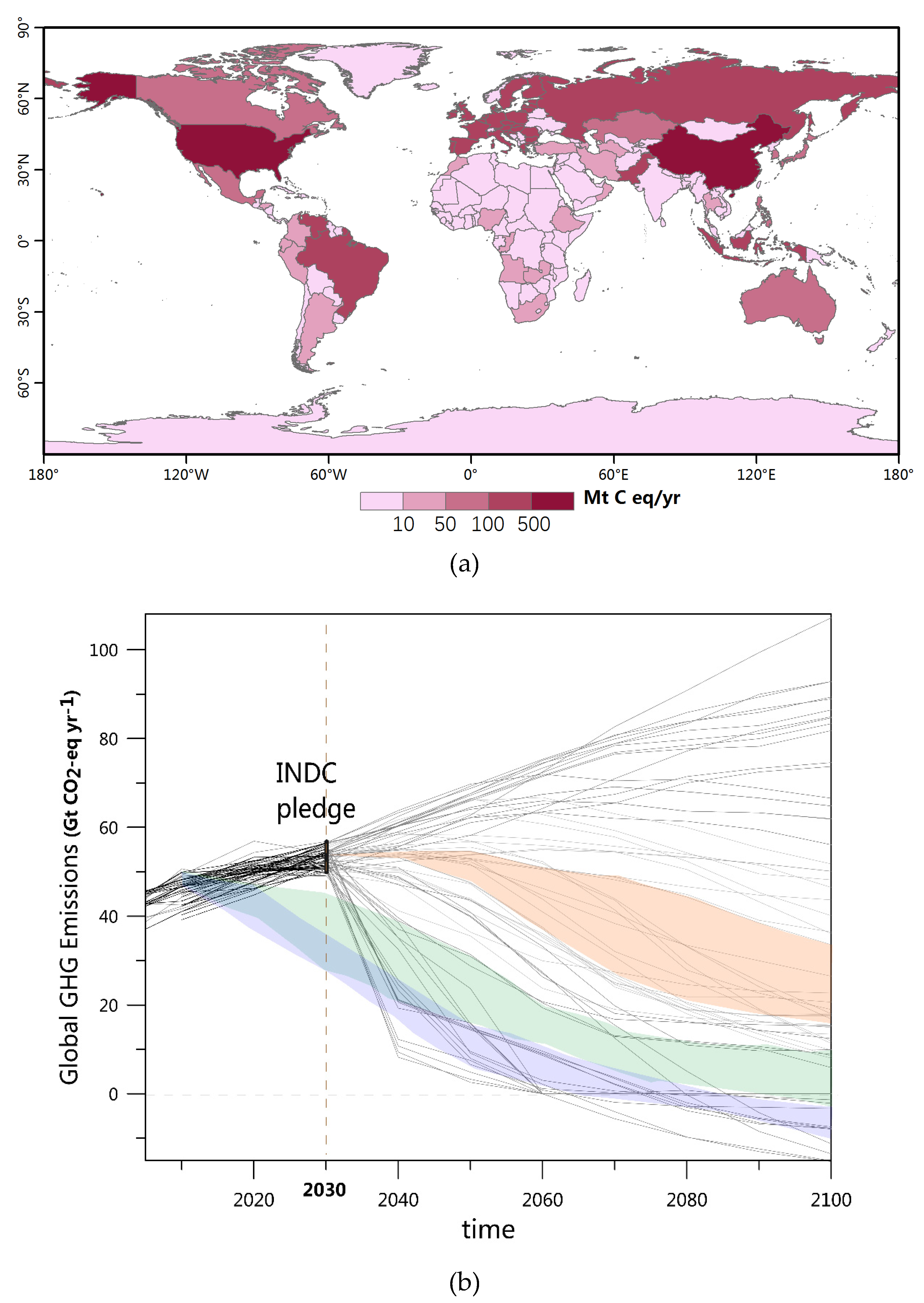
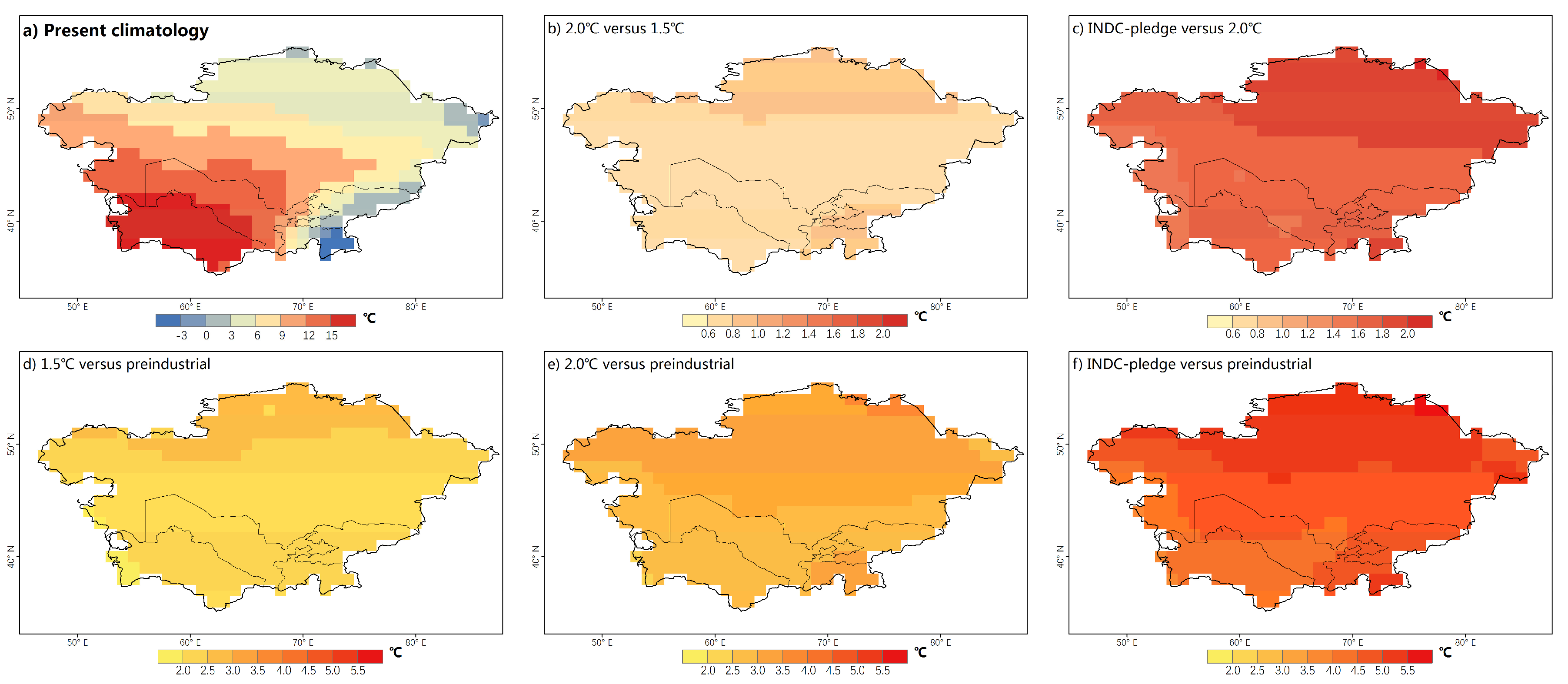

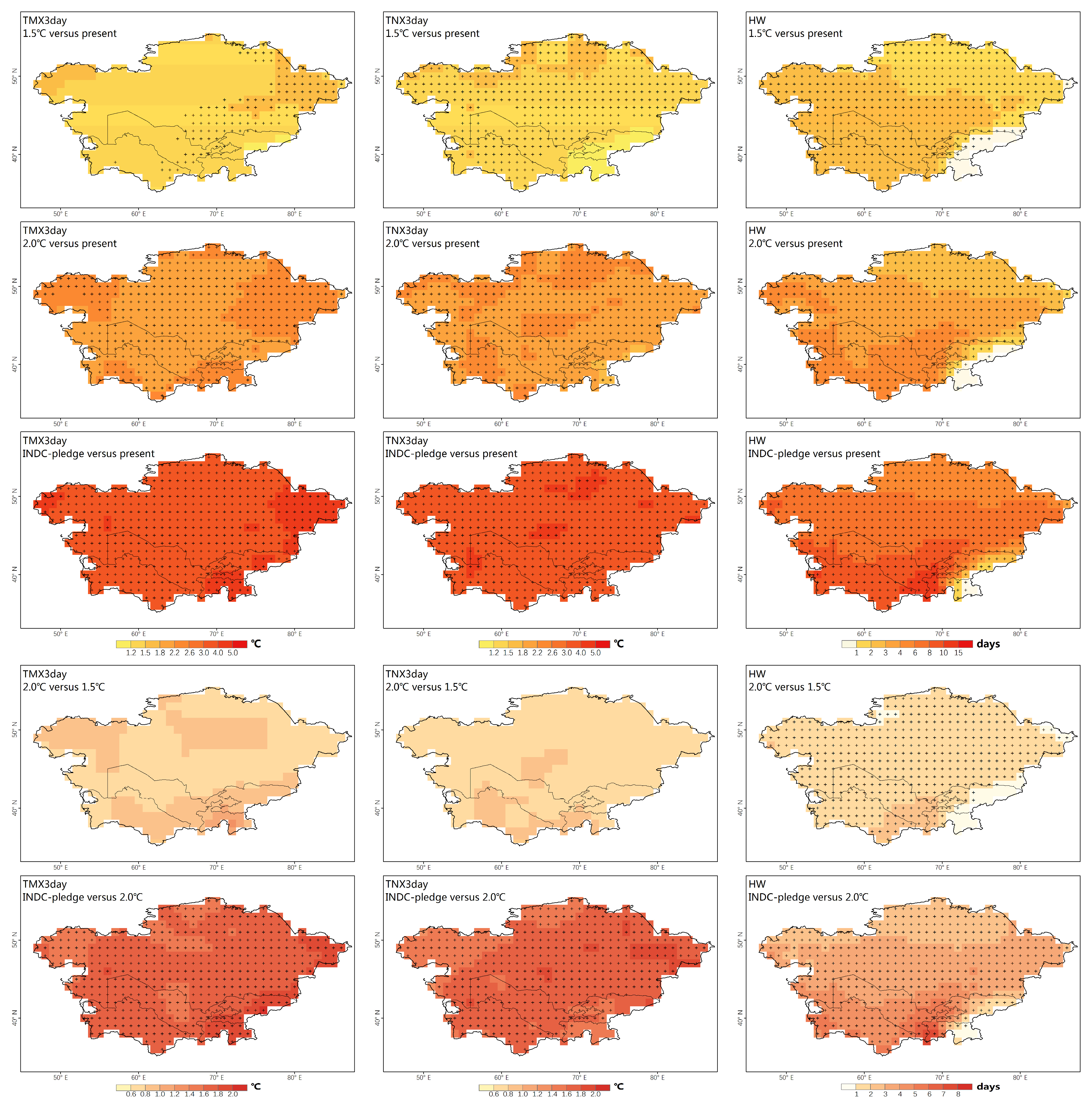
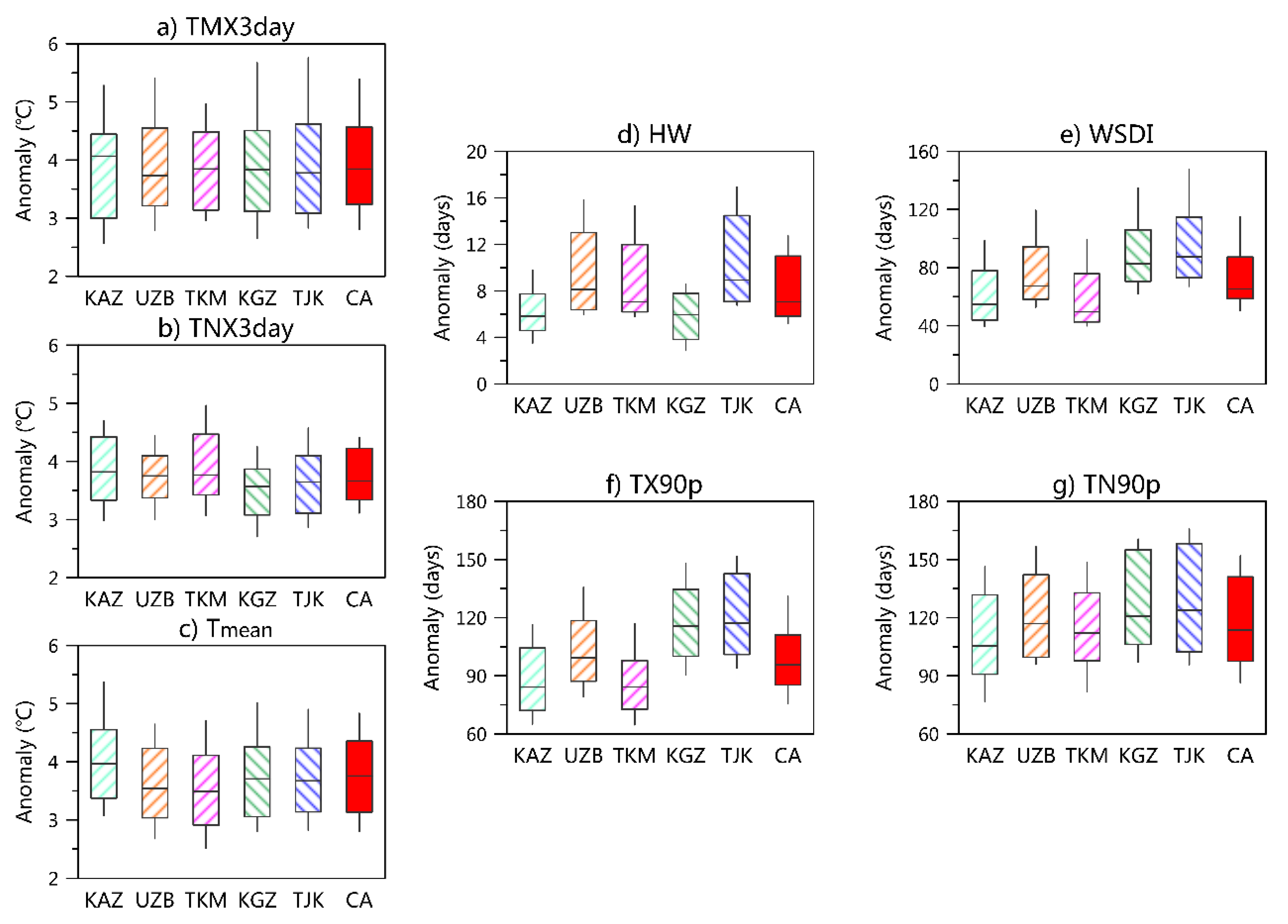
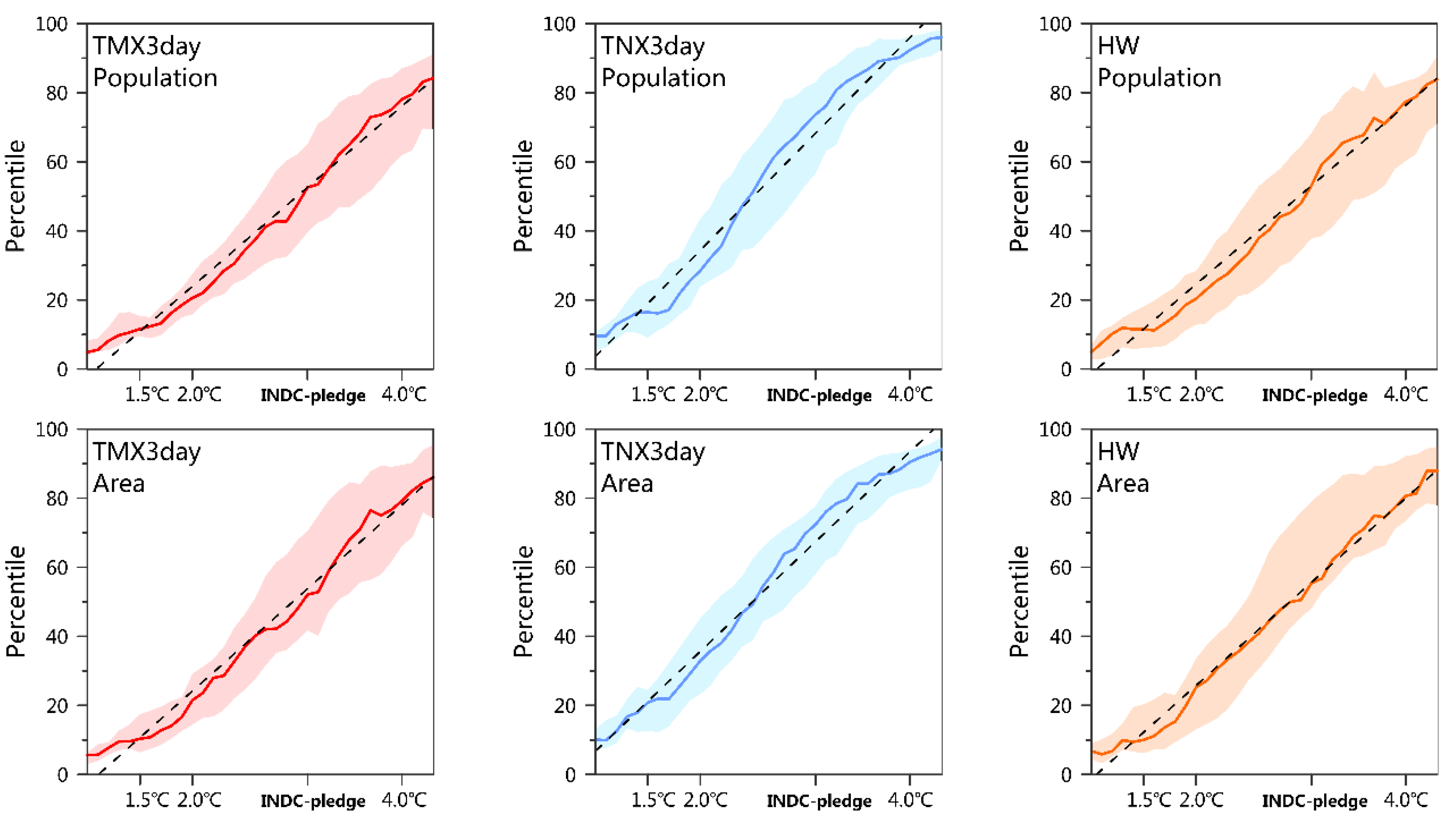
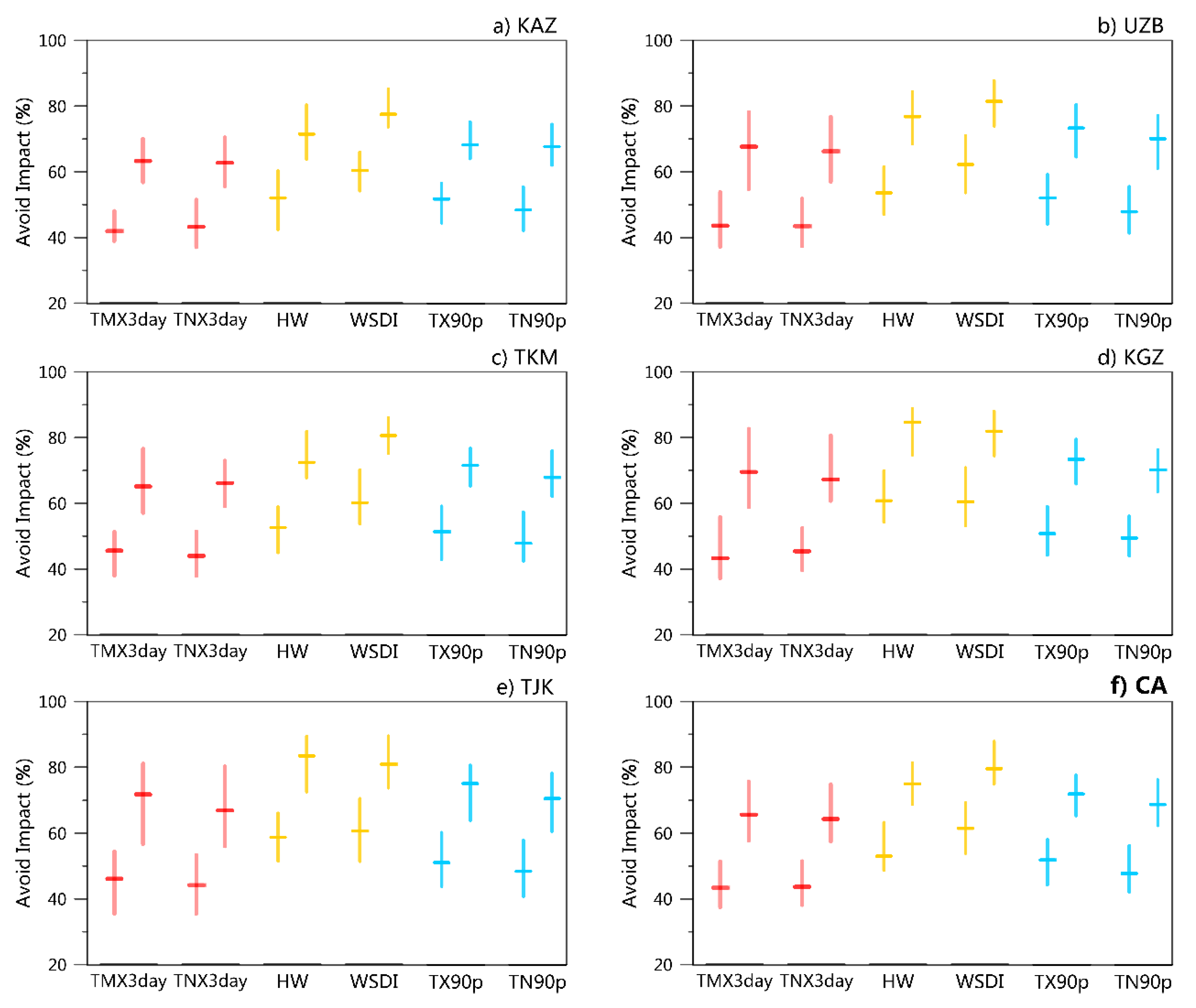
| Name | Label | Definition (Unit) |
|---|---|---|
| Three-day warm day event | TMX3day | The highest three-day mean daily maximum temperature in a year (°C) |
| Three-day warm night event | TNX3day | The highest three-day mean daily minimum temperature in a year (°C) |
| Heat wave duration index | HW | The longest consecutive period of at least three days during which the daily maximum temperature exceeded the 95th percentile of the base period of 1961–1990 and the percentile threshold was ≥30 °C (days). The specified percentile of the base period is calculated on moving daily data with a five-day window, similarly hereinafter in this table. |
| Warm spell duration index | WSDI | Annual number of days with at least six consecutive days during which the daily maximum temperature (TX) >90th percentile (days) |
| Warm days | TX90p | Let TXij be the daily maximum temperature on day i in period j, and let TXin90 be the calendar day 90th percentile centered on a five-day window for the base period of 1961–1990. The number of days is determined during which TXij > TXin90 (days) |
| Warm nights | TN90p | Similar to TX90p, but for the daily minimum temperature (days) |
© 2019 by the authors. Licensee MDPI, Basel, Switzerland. This article is an open access article distributed under the terms and conditions of the Creative Commons Attribution (CC BY) license (http://creativecommons.org/licenses/by/4.0/).
Share and Cite
Zhang, J.; Wang, F. Regional Temperature Response in Central Asia to National Committed Emission Reductions. Int. J. Environ. Res. Public Health 2019, 16, 2661. https://doi.org/10.3390/ijerph16152661
Zhang J, Wang F. Regional Temperature Response in Central Asia to National Committed Emission Reductions. International Journal of Environmental Research and Public Health. 2019; 16(15):2661. https://doi.org/10.3390/ijerph16152661
Chicago/Turabian StyleZhang, Jintao, and Fang Wang. 2019. "Regional Temperature Response in Central Asia to National Committed Emission Reductions" International Journal of Environmental Research and Public Health 16, no. 15: 2661. https://doi.org/10.3390/ijerph16152661
APA StyleZhang, J., & Wang, F. (2019). Regional Temperature Response in Central Asia to National Committed Emission Reductions. International Journal of Environmental Research and Public Health, 16(15), 2661. https://doi.org/10.3390/ijerph16152661





